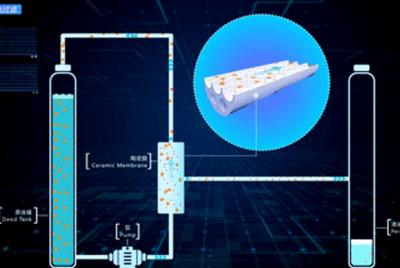Erythritol is also known as phycite, and its chemical name is 1,2,3,4-erythritol. Widely distributed in nature, it has been a component of human diets for tens of thousands of years in seaweed, mushrooms, melons, grapes and many fermented foods. Erythritol is 60% sweeter than sucrose, and only 10% caloric than sucrose, which has become a research hotspot for a new type of sweetener. Erythritol has the functions of sugar alcohol products, such as preventing dental caries, suitable for diabetic patients, etc. It has been widely used in food, beverage, medicine and other fields as a health food raw material.
The production history of erythritol in China is still relatively short and the scale is relatively small, and the concentration of the target product in the erythritol fermentation broth produced by industry is very low, generally only about 0.1% to 20% of the volume of the fermentation broth, which also contains a large amount of impurities (such as mycelium, protein, intermediate metabolites). To prepare high-purity products that meet food-grade or pharmacopeia regulations, a large amount of impurities in the fermentation broth must be removed. At present, the sterilization and filtration of most fermentation broths still use separation equipment such as plate and frame, drums, centrifuges, etc. or methods such as flocculation and sedimentation, and these methods can only remove the mycelium, solid impurities and other solids in the fermentation broth. However, it is impossible to separate the soluble proteins and macromolecular organic substances that exist in large quantities in the fermentation broth, and these impurities will have an impact on the subsequent extraction process and the quality and yield of the final product.
With its unique separation advantages, Jiuwu Hi-tech membrane separation technology realizes the separation of mixtures of different particle sizes, and has a wide range of applications in the field of extraction and separation of fermentation broth. Compared with the traditional technology, the ceramic membrane filtration of erythritol fermentation broth has the following advantages:
(1) Ceramic membrane filtration technology has short technological process, less equipment, less land occupation and low operating cost.
(2) The performance of erythritol fermentation broth is stable in the method of ceramic membrane filtration, and the quality of permeate liquid is stable.
(3) The sterilization effect of ceramic membrane filtration is good, and the permeating clear liquid is sterile clear liquid, which provides a reliable and powerful guarantee for the microbial quality control of the finished product.
(4) The recovery rate of erythritol is high, up to 98%.
If the treatment capacity is 100 m3/d, let's compare the effect of filtration of erythritol fermentation broth by plate and frame and membrane separation technology on the operating cost of separation and purification process of erythritol. In the process, ceramic membrane filtration has great advantages over plate and frame filtration. If the treatment capacity is 100 m3/d, we can save 760 t diatomite per year, and according to the market price of 2,000 yuan/t, we can save at least 1.5 million yuan per year. It also saves the workload of replacing the filter cloth, greatly reduces the labor of the workers, and reduces the labor cost by about 100,000 yuan.




 +86-25-58849045
+86-25-58849045
 +86-25-58749295
+86-25-58749295
 jiuwu@jiuwu.com
jiuwu@jiuwu.com
 No. 9 Park Road, Pukou District, Nanjing City (Sanqiao Factory)
No. 9 Park Road, Pukou District, Nanjing City (Sanqiao Factory) Call us on:
Call us on:  Email Us:
Email Us:  No. 9 Park Road, Pukou District, Nanjing City (Sanqiao Factory)
No. 9 Park Road, Pukou District, Nanjing City (Sanqiao Factory)

 English
English 한국어
한국어 français
français русский
русский Español
Español

